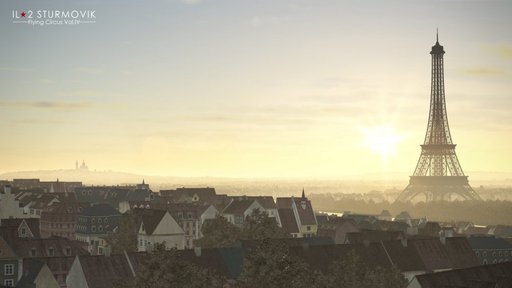
Dear Friends,
We would like to let you know that the development of Flying Circus Vol.IV is nearing its end. All of its planes will be released simultaneously in one big update that will be released soon - it is currently in the beta testing phase.
It will bring seven new planes: Airco D.H.2, Albatros D.III, Fokker E.III Eindecker, Roland C.IIa and Sopwith ones - Pup, 1½ Strutter and single-seat Scout 1½ Strutter (Strutter B). In addition to these new aircraft, there are extensive changes to the Western Front WWI map - unlike the new aircraft, these changes will be available to owners of any Flying Circus module. Dozens of new settlements, factories, and airfields are being added, including Paris.
The early World War I Airco D.H.2 and Fokker E.III did not even have a throttle (to reduce engine speed, the pilot had to hold down an ignition switch called a blip switch). In addition, the Airco had a pusher propeller instead of the usual puller propeller to allow forward firing - at the time, this technical task prompted exotic solutions, such as attaching metal deflector wedges to the propeller blades so that projectiles hitting the blades would ricochet. Needless to say, this was a dangerous arrangement that tended to damage the propeller anyway. Sir Geoffrey de Havilland used the development of the "pusher" propeller concept for Airco, where the propeller is located behind the pilot, to get around this problem and make forward firing unobstructed.
After the capture of a French aircraft equipped with metal deflector wedges attached to the propeller blades, Anthony Fokker chose an alternative approach to the problem by creating a gear assembly that connected the shaft of the engine to the trigger of the machine gun. Bullets would be fired only after the propeller blade had cleared the front of the machine gun muzzle and during the gap left as each blade moved in turn around the spinner. Thanks to this invention, the Fokker E.III, the legendary monoplane, was equipped with a synchronizer mechanism, a revolutionary innovation that changed the face of air combat: it was now possible to fire a machine gun through a rotating propeller without damaging it.
This device drastically improved the performance of aircraft in the fighter role: German aircraft dominated the skies until early 1916. This period was known as the "Fokker Scourge." At the same time, biplanes did not have ailerons - roll control was achieved by physically deforming the entire surface of the wings ("wing warping"). This unreliable and ineffective function was replaced by ailerons in later designs.
These exotic features make flying one of them a unique experience even for a seasoned virtual pilot.
Other planes in the list are much more like the planes we are used to - aircraft innovation happened really fast in this era. They are interesting in their own way. For example, the high production rate of the Albatros D.III (1346 built in total) resulted in numerical superiority for German aviation in April 1917, known as the "Bloody April", and its flight characteristics allowed it to remain in frontline service until the fall of 1918 - a very long time for an era when a new design could change the situation in the air very quickly.
The ambition of engineer Tantzen, who designed the Roland C.II, was to present a drastically cleaned-up airframe, eliminating as much as possible the "built-in" drag of the inter-plane, center section strut arrangements, and associated bracing. The streamlined fuselage design and thin wing profile resulted in great performance for its time. It was one of the fastest planes at the front, able to outrun any enemy fighter, but due to its wide oval fuselage and aft pilot position, it was a very unforgiving plane to land: very few pilots who flew this plane did not crash or damage it during landing. Because of its performance, it was often used as a strategic reconnaissance aircraft, capable of flying deep into enemy territory - Allied aircraft couldn't catch it. Later, when the Allies introduced faster fighters, the Rolands were used in close support and reconnaissance roles and were slowly withdrawn from front-line units by June 1917.
The Sopwith 1½ Strutter took its name from the arrangement of the center section of the upper wing - "one and a half" (long and short) pairs of struts supporting the upper wing. It was the first true two-seater fighter to enter service and, in fact, the first British aircraft armed with a synchronized machine gun. The B variant did not have an observer and turret-mounted machine gun - four 65 lb H.E.R.L. bombs were carried in the second cockpit and dropped through the opening below.
The Sopwith Pup was officially designated the 'Sopwith Scout', but soon became nicknamed the 'Pup' due to its similarity to the 1½ Strutter (but with smaller proportions). The Pup nickname was never officially recognized, but it started the tradition of naming all later Sopwith aircraft after a bird or animal. Manfred von Richthofen, after encountering the Pup in combat, remarked, "We saw at once that the enemy plane was superior to ours." The excellent combination of the Pup's light weight and large wing area allowed British pilots to outperform the enemy in dogfights. British ace James McCudden remarked, "It was so extremely light and well surfaced that with a little practice, you could almost land it on a tennis court." As a result, the Pup became the first aircraft to land aboard a moving ship, HMS Furious, on August 2, 1917.
In addition to the WWI additions and improvements, there will be a lot of other changes from the career mode including new mission types to the correction of certain aircraft such as the Tempest. We hope to release the new huge update as soon as possible, in a few weeks - please stay tuned!





